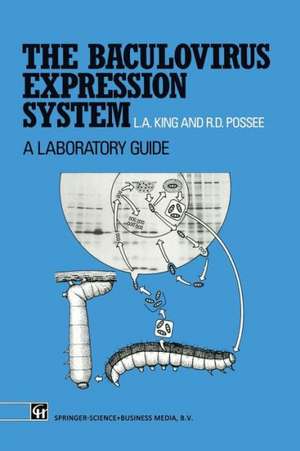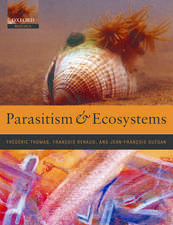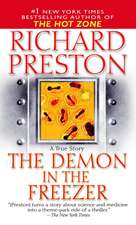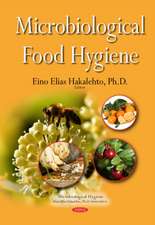The Baculovirus Expression System: A laboratory guide
Autor Linda Kingen Limba Engleză Paperback – 5 noi 2012
Preț: 496.99 lei
Preț vechi: 584.69 lei
-15% Nou
Puncte Express: 745
Preț estimativ în valută:
95.10€ • 99.75$ • 79.17£
95.10€ • 99.75$ • 79.17£
Carte tipărită la comandă
Livrare economică 01-15 aprilie
Preluare comenzi: 021 569.72.76
Specificații
ISBN-13: 9789401050470
ISBN-10: 9401050473
Pagini: 248
Ilustrații: XIV, 229 p.
Dimensiuni: 155 x 235 x 13 mm
Greutate: 0.35 kg
Ediția:Softcover reprint of the original 1st ed. 1992
Editura: SPRINGER NETHERLANDS
Colecția Springer
Locul publicării:Dordrecht, Netherlands
ISBN-10: 9401050473
Pagini: 248
Ilustrații: XIV, 229 p.
Dimensiuni: 155 x 235 x 13 mm
Greutate: 0.35 kg
Ediția:Softcover reprint of the original 1st ed. 1992
Editura: SPRINGER NETHERLANDS
Colecția Springer
Locul publicării:Dordrecht, Netherlands
Public țintă
ResearchCuprins
1 The baculoviruses.- 1.1 Introduction.- 1.2 Isolation and host range.- 1.3 Structure and classification.- 1.4 Baculovirus replication in vivo.- 1.5 Baculovirus replication in vitro.- 1.6 Genetic engineering of baculovirus insecticides.- 2 The development of baculovirus expression vectors.- 2.1 Introduction and historical perspective.- 2.2 The merits of the baculovirus expression system.- 2.3 General principles for inserting foreign genes into the baculovirus genome.- 2.4 Baculovirus transfer vectors.- 2.5 Selection of recombinant viruses.- 3 Processing of foreign proteins synthesized using baculovirus vectors in insect cells.- 3.1 Introduction.- 3.2 Glycosylation.- 3.3 Phosphorylation, acylation and amidation.- 3.4 Proteolytic processing.- 3.5 Cellular targeting and secretion.- 3.6 Tertiary and quaternary structure formation.- 3.7 Expression of viral genes.- 3.8 Expression of bacterial and fungal genes.- 3.9 Post-transcriptional processing.- 4 Construction of transfer vectors containing the foreign gene.- 4.1 Introduction.- 4.2 Isolation of foreign gene coding sequences.- 4.3 Modifying the ends of DNA molecules.- 4.4 Preparation of the transfer vector.- 4.5 DNA ligations.- 4.6 Transformation of bacteria.- 4.7 Screening for recombinant baculovirus transfer vectors.- 4.8 Analysis of recombinant transfer vectors.- 4.9 Isolation of highly purified plasmid DNA (maxi-preps).- 5 Insect cell culture media and maintenance of insect cell lines.- 5.1 Introduction.- 5.2 Cell lines.- 5.3 Culture media.- 5.4 Preparation of culture media.- 5.5 Glassware and disposable plasticware.- 5.6 Insect cell culture.- 5.7 A guide to Sf cell seeding densities for experimental work.- 5.8 Freezing, storage and recovery of insect cells in liquid nitrogen.- 5.9 A guide to adapting cells to serum-free media.- 6 Propagation, titration and purification of AcMNPV in cell culture.- 6.1 Introduction.- 6.2 Infection of cells with virus for experimental work.- 6.3 Titration of virus by plaque-assay.- 6.4 Plaque-picking and plaque-purification.- 6.5 Amplification of virus stocks.- 6.6 Large-scale production of virus for the purification of virus particles.- 6.7 Purification of infectious virus DNA.- 6.8 Titration of virus by TCID50.- 7 Production and selection of recombinant virus.- 7.1 Introduction.- 7.2 Preparation of linear AcMNPV.lacZ (or AcMNPV.SC) DNA.- 7.3 Co-transfection of insect cells.- 7.4 Separation of parental and recombinant viruses by plaque-assay.- 7.5 Plaque-purification and amplification of recombinant virus stocks.- 7.6 Amplification and detection of recombinant viruses by limiting dilution and dot-blot hybridization.- 8 Characterization of recombinant viruses.- 8.1 Introduction.- 8.2 Analysis of recombinant virus genomes.- 8.3 Analysis of foreign gene expression by polyacrylamide gel electophoresis, using unlabelled or radiolabelled cell proteins.- 8.4 Analysis of recombinant protein synthesis in insect cells using immunological techniques.- 8.5 Analysis of post-translational processing events in insect cells.- 8.6 Analysis of transcription in recombinant virus-infected cells.- 9 Scaling up the production of recombinant protein in insect cells; laboratory bench level.- 9.1 Introduction.- 9.2 Large-scale culture of insect cells.- 9.3 The importance of highly infectious virus stocks.- 9.4 Multiplicity of infection.- 9.5 The optimum time to harvest virus-infected cells.- 9.6 Purification of recombinant protein from infected cell cultures.- 10 Propagation of baculoviruses in insect larvae.- 10.1 Introduction.- 10.2 Rearing insects in the laboratory.- 10.3 Infection of insect larvae with polyhedra from cell culture.- 10.4 Purification of polyhedra from infected larvae.- 10.5 Bioassays of polyhedra.- 10.6 Purification of virus particles and DNA from polyhedra.- 10.7 Isolation of virus particles from infected larvae to establish infections in cell culture.- 10.8 Preparation of semi-synthetic insect diet.- 11 Trouble-shooting guide.- 11.1 Introduction.- 11.2 Insertion of foreign gene coding sequences into transfer vectors.- 11.3 Cell culture.- 11.4 Preparation of virus stocks and infectious DNA.- 11.5 Co-transfections.- 11.6 Baculovirus plaque-assays.- 11.7 Screening for recombinant viruses.- 11.8 Instability of recombinant viruses.- 11.9 Poor yields of recombinant protein.- Appendix A list of selected suppliers.- References.








